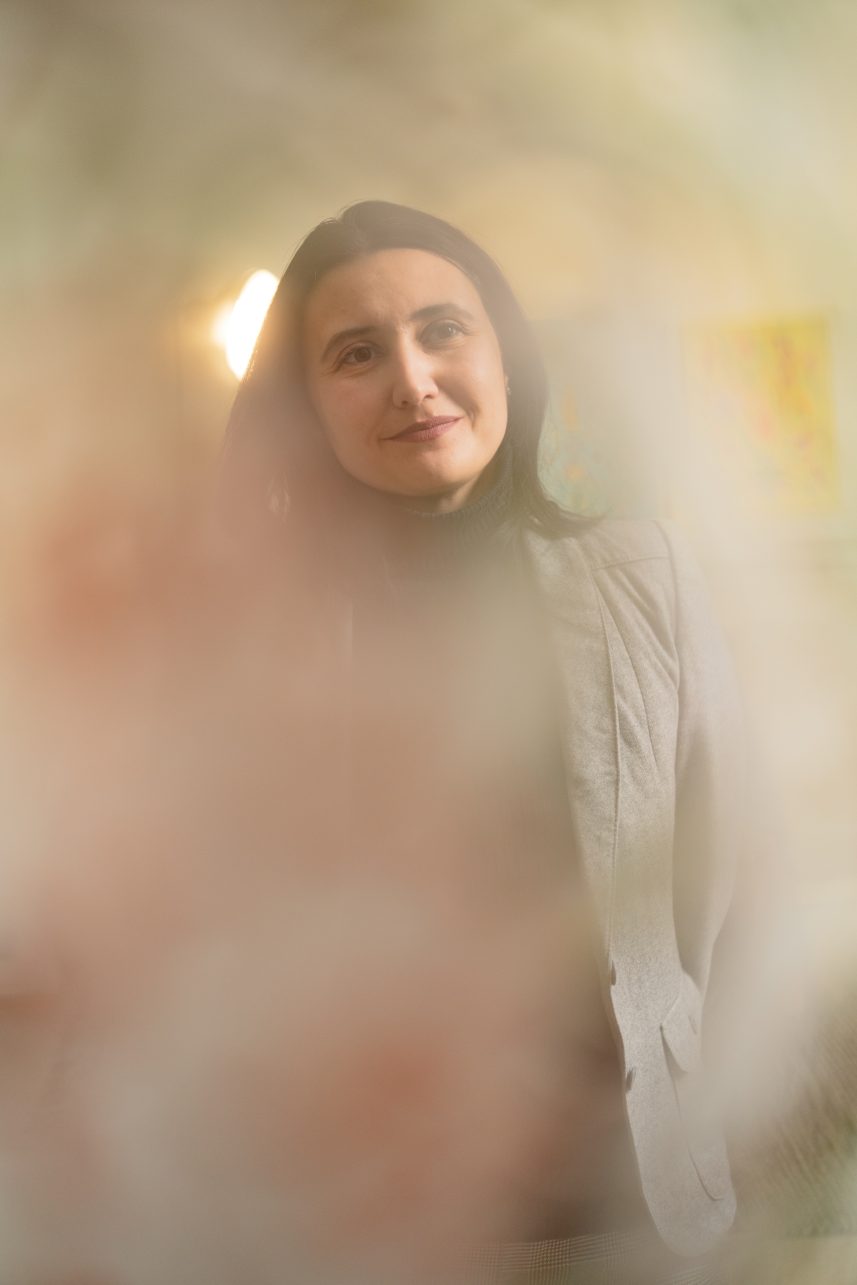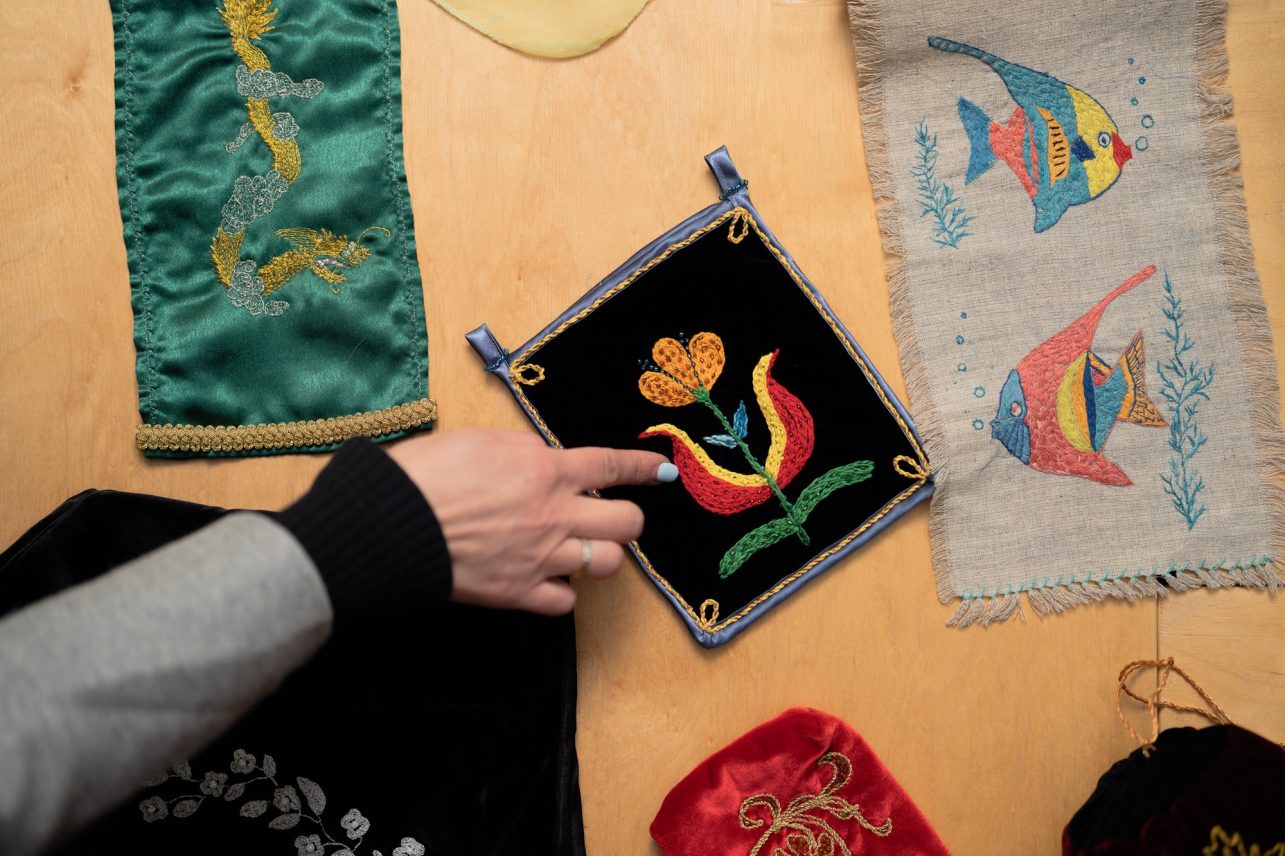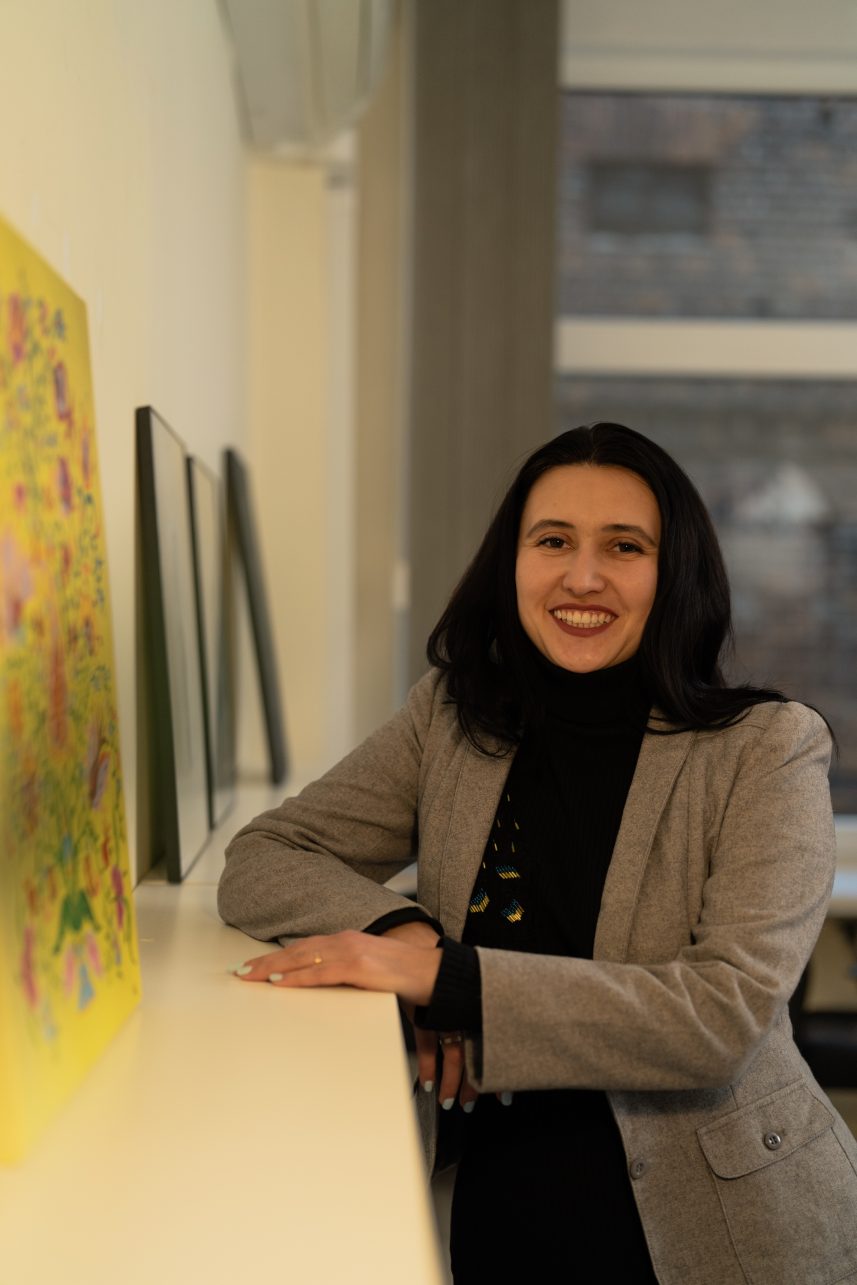May will mark the 80th anniversary of the deportation of the Crimean Tatars called Sürgünlik. The deportation began on May 18 at 3 a.m. and ended on May 20. 32 thousand NKVD officers participated in the operation during which they deported about 200 thousand local residents. This is how the family of my interviewee Elvira Drozdova ended up in Uzbekistan. She was born there but later moved back to her homeland. We met Elvira at the Kaunas Cultural Center, where her painting and textile art exhibition Örnek Ornaments was held. Örnek is an ornament that combines about 35 small botanical and geometric elements into a single system. It is like a tree of life that grows by embroidering, weaving, sculpting, engraving, or carving, and thus immortalizing the history of one’s family and the nation.

Elvira, how did you find yourself in Kaunas?
My family and I have been living in Kaunas for seven years. I am a Crimean Tatar, but I was born in Uzbekistan. My relatives were deported to this country from Crimea. Well, my husband has Lithuanian roots and always wanted to come back to live here. I told him that my homeland was Crimea, and I wanted to live there. And we had a very good time there, there were no reasons to leave. However, I had promised him that if the situation changed, we would go to Lithuania. Of course, I talked about this long before the occupation and I did not think that we would ever reach a point when it would be necessary to leave. And when it started, we both realized that we had to say goodbye to normal life. So, we left before the referendum that was held in March 2014. We had to leave because my husband was an activist, and it was dangerous for him to stay. We spent more than two years in Lviv, but it felt more like survival rather than life. It was difficult financially, our accounts were blocked, and things like that. My husband said: that’s it, I want to go to Lithuania. We learned about a special program for those with Lithuanian roots. My husband’s grandmother is Lithuanian, and his grandfather was a Crimean Karaite. That’s how we found ourselves in Lithuania.
You have discovered a very old local Tatar community in Lithuania, right?
This was not news. Tatars living in Crimea know that we have a common history with Lithuania, which has been going on for centuries. Maybe not everyone living in Lithuania knows how much we really have in common. My husband has told me a lot about this before we knew that we would really have to go to Lithuania.
You speak Lithuanian perfectly. You even write in Lithuanian on Facebook. Is it thanks to your husband?
My husband spoke fluently as a child, but he studied at school in Russian, so he forgot his mother tongue. He can speak but finds it difficult. And I started learning as soon as we arrived. I make a lot of mistakes, but I don’t dwell on them. Now it is easier for me to speak Lithuanian than, say, English. Everyone says I speak perfectly, and it’s nice, I am grateful, but I would say it is not yet perfect [laughs].
How did art and crafts come into your life?
I am the fourth generation of embroiderers! My great-grandmother, grandmother, and mother also embroidered. I started when I was a child and we lived in Uzbekistan. First, to draw. I was immediately interested in the örnek, an ornament of the Crimean Tatars, which was recently included in the UNESCO World Intangible Cultural Heritage list. When my family and I came to Crimea, we felt sad. Do you know why? Because our nation is a nation of exiles. It was difficult for us to preserve our language, traditions, culture, and art. It was only around 1990 that people in Crimea began to talk more seriously about these issues, and started collecting material from folk artists, and organizing all the information.

I do not want our nation to be erased from history, so it is important for me to tell everyone who and what the Crimean Tatars are. I chose art to help me do so. I present örnek, organize exhibitions, and lead educational activities. I worked as a teacher in Crimea, and here, in Kaunas, I have already founded the Embroidery Academy – courses where I teach this technology and explain the meanings of geometric and botanical symbols. There is also a painting studio, where we paint Tatar ornaments. I must say that everybody is interested in the meanings of the symbols. In my paintings, you see trees of life. Every family can create one by adapting specific elements that help convey the family story. This is what attracts the curious. So, for them, it’s a beautiful way to art, and for me, it’s a way to preserve my culture.
So, not only Kaunas residents of Tatar origin are interested?
Now I don’t even have Tatars in my embroidery course. By the way, I recently looked at the Lithuanian list of professions, you know, with codes. I found an embroiderer and was surprised. It was just an embroiderer, that’s all! In Ukraine, we have five levels. For example, some people think that if they know how to do cross-stitch, that’s a good enough level. Well, it’s like paint by numbers. As a hobby or meditation – sure, but if you actually create, things get more complicated. Therefore, my course lasts several months and is not very cheap. Not everyone has enough motivation.
I notice that Lithuanians are interested in the gold and silver threads we use for embroidery. In general, there is a stereotype in Europe that gold is for monarchs and churches. But then I tell them about the traditional costume of the Crimean Tatars and emphasize that our nation was rich. In every family, everyone, from the youngest to the oldest, had clothes embroidered with gold and silver threads. There were many craftsmen engaged in this work. Crimean Tatar artisans were awarded a bronze medal at the International Exposition of Art and Technology in Modern Life in Paris during the interwar period.

What makes traditional embroidery attractive to the modern urbanite?
Just a few days ago, we were talking about this with a friend. She said, you know, not everyone finds folk art interesting. I am sorry, I said, but that’s not true! People want to be unique, to dress beautifully. But not everyone can afford high fashion. And it is embroidery that allows you to turn even the simplest garment into a truly original and stylish one. In this way, you can renew old clothes and stylishly mask the signs of time. You can pay a professional who will do it flawlessly, but you can certainly learn how to embroider well too. Good artisans will always be in need. After all, exclusive handmade costumes are always needed in theatre and cinema.
Another thing is that embroidery can also be modern. You can embroider anything with everything. Even dental floss can be used if you have imagination and come up with an appropriate concept. It is possible to mix embroidery with appliqué or collage.
And when you work, do you get tired or on the contrary, feel like you’re resting?
It would help if you got a good night’s sleep before starting embroidery [laughs]. It often takes me all night because I just can’t stop. So yes, it is like meditation, but embroidery also requires meticulousness. I would compare it with jewelry. The process can be really slow. But I emphasize to all students that, even if they get too immersed in it, they need to force themselves to stop and have breaks. Go outside to have a breath of fresh air or look out the window. This is very important, otherwise, their eyes, head, and back will get sore.
Both embroidered and painted works are displayed in your exhibition. How do you choose a technique?
I can’t limit myself to one area. I really like textile art, but it is not enough for me. If we talk about traditional ornaments, yes, everyone wants to see them embroidered on fabric. I have many such works, but they are not paintings. By the way, I will open an exhibition of embroidered works in Kėdainiai in June. And painting is my passion. I paint with acrylic on canvas, and when I get tired of it, I move to watercolour and then… go back to embroidery. That’s how the wheel turns. One acquaintance mentioned that such a variety of techniques is like my business card.

But, Elvira, you are also a programmer, a lawyer…
You know everything [laughs]. After all, my first profession is embroidering. I continued my studies after that, in two faculties at once. I worked as a lawyer, and then as a programmer. When I left for Lviv, it was difficult, I didn’t think about work, because at that time I was pregnant, and my older daughter had health problems. She is gluten intolerant. It turned out that in Ukraine, public kindergartens cannot provide children with special meals. What a shame, I thought. I found more families with this problem. So, you can imagine if a child can’t eat kindergarten food, then they don’t attend it. Consequently, one parent needs to take time off work or hire a full-time nanny. I communicated with institutions and initiated a special project. You know, they tell me in Lithuania: oh, we have such a huge bureaucracy. Yes, it is rather complicated, but you have no idea how things are in Ukraine. I was very inspired by a particular kindergarten in Riga. I visited it recently, I got to know everyone, I was very happy. By the way, there is a kindergarten called Klevelis in Kaunas, where children with allergies are welcome. It is a great one, I speak from experience.
I like the carnation – it is a symbol of perseverance, strength, and sacrifice.
I started all that work in 2014 but it was only in 2017 that we managed to apply special nutrition plans in one group of one kindergarten in Lviv. It was a huge sensation in the whole of Ukraine. Little by little, those groups increased in number. I worked on the project even after I moved to Kaunas. And then, a war broke out…
After I settled in Lithuania, I started thinking about how to apply my knowledge. In order to work in the field of law, one should know the Lithuanian language very well. I can help Ukrainians in this field, but I cannot do it professionally. So, I founded the Embroidery Academy.
When this issue comes out, we will have marked two years since the start of the war and ten years since the annexation of Crimea. Is it a coincidence that the exhibition is being held right now?
I did not plan the date specifically. I create here and there and now I have a bit more time since my children are a bit older. But just as they grew a bit, the war started. It was really, really hard for me, I went through the same thing again as in 2014. Not all Ukrainians understood me when I came here from Lviv. What that feeling is like and what it means to be forced to leave your homeland. In short, we are all in Kaunas, there is war in Ukraine, and I am in shock, I cannot do anything. I realized I needed therapy. I started drawing simple illustrations like one would for a children’s book. We haven’t had a TV at home since 2007. So, my children learned what war is from those sketches.
And I was relieved when I drew. One acquaintance told me: you know, you should organize an exhibition; your works are so soft and sensitive. After all, everyone sees photographs and video material, but it is only in artworks that you can see how people really feel. I contacted female artists I knew and sent them photos of my work, and they sent me theirs. Exhibitions were held in other countries too and also in Kaunas, on the premises of the Lithuanian Union of Political Prisoners and Deportees. Many people came to see it.
Can you share with us what your favorite örnek symbols mean?
I used a pomegranate and a bean for the Embroidery Academy’s logo. A pomegranate is a sign of family prosperity, and a bean is like a tree of life. I also like the carnation – it is a symbol of perseverance, strength, and sacrifice. It can also mean old age. The context is of importance here: what is in the middle, what is around the edges; where did that flower grow from, and so on. It is like a puzzle of symbols that we create by putting the desired meaning into it. Örnek is a language of ornaments, not just fancy drawings of birds and flowers. It is because of these nuances that it was recognized by UNESCO.




